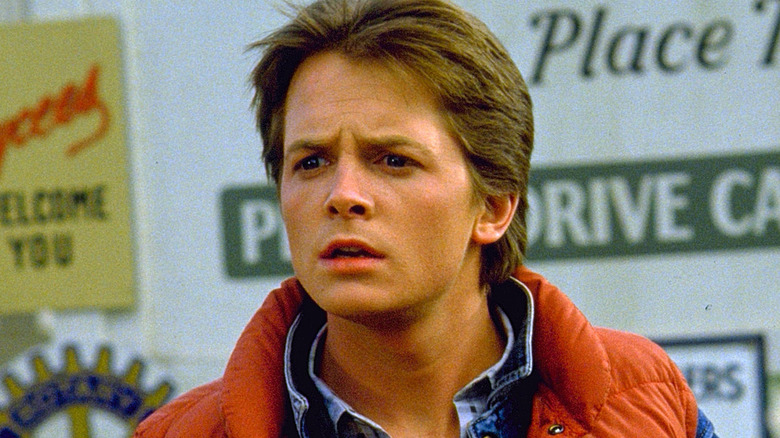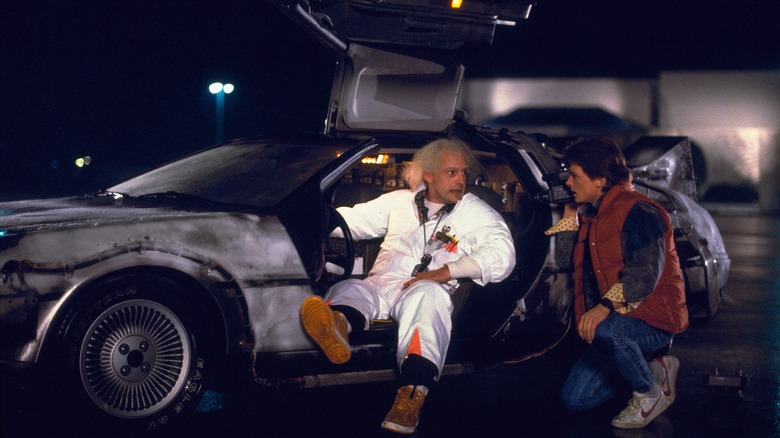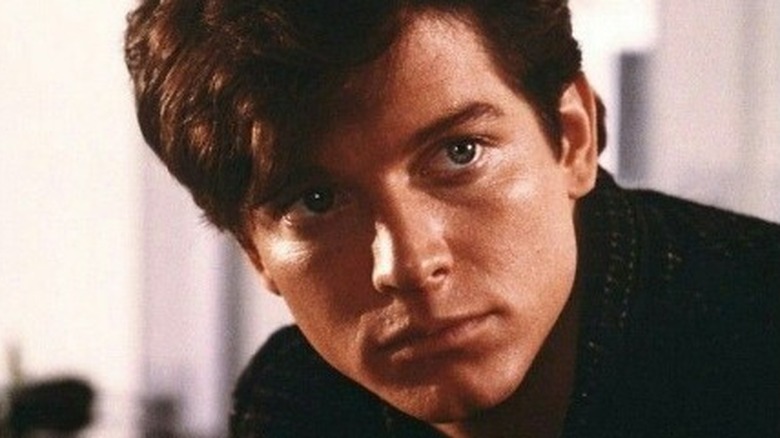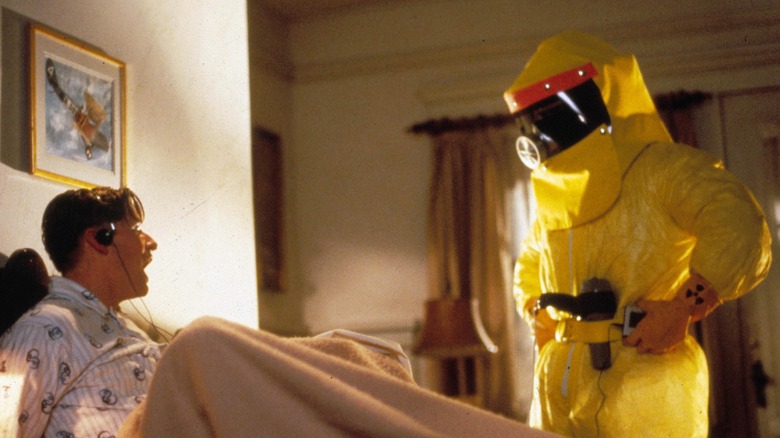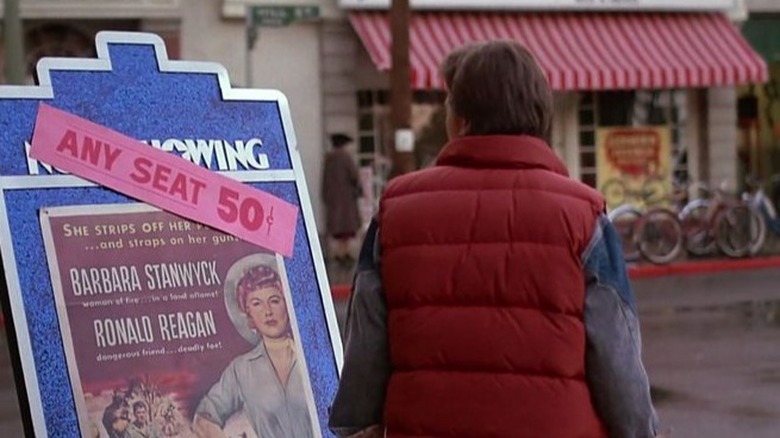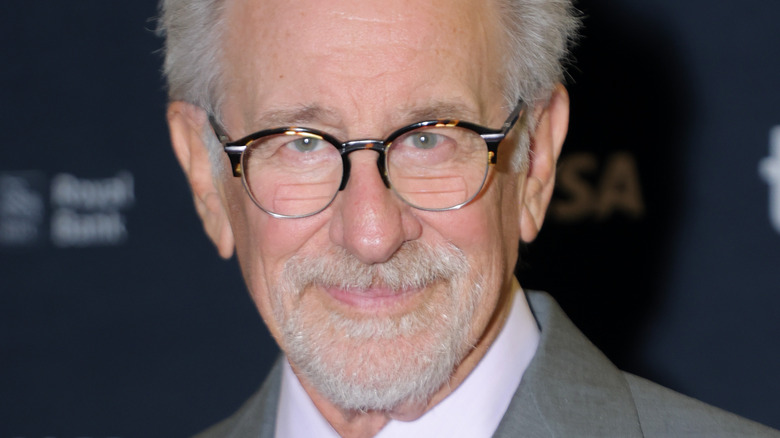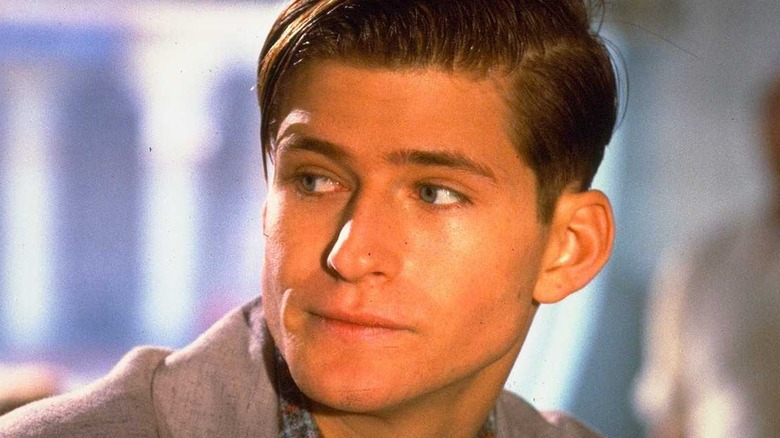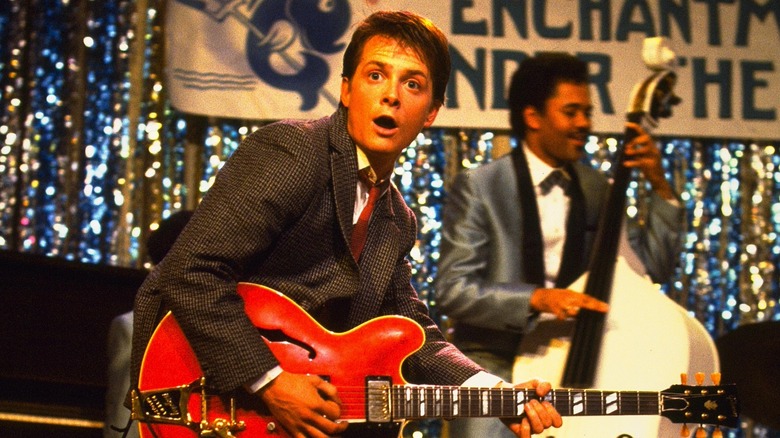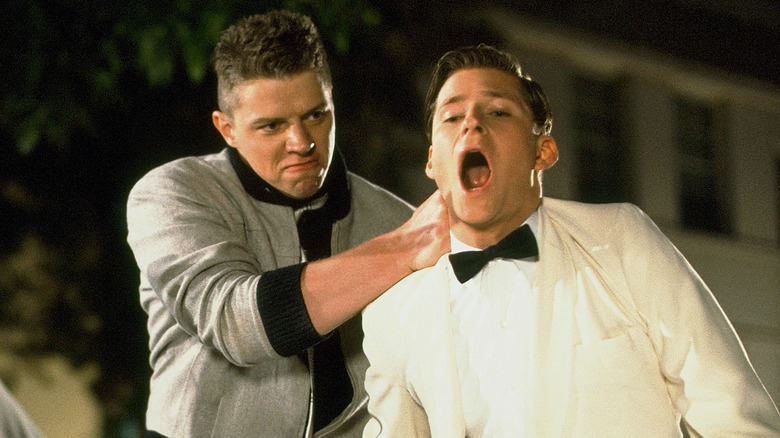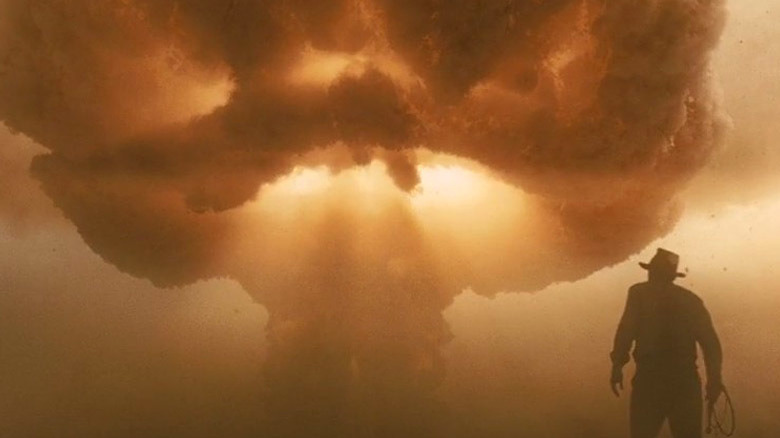The Fascinating Origins Of Back To The Future
Great Scott! Get those flux capacitors fluxing and your DeLorean's engine running, 'cause it's time to talk about one of the greatest movies ever made: "Back to the Future." From the minds of Robert Zemeckis and Bob Gale came everyone's favorite time-traveling adventure back in 1985, and from there grew into a beloved franchise with three movies, one video game, and even a successful musical.
"Back to the Future" follows the story of Marty McFly, a teenager living in Hill Valley, California, as he gets put into a complicated situation after his friend, Doctor Emmett Brown, invents a time-traveling car. From there, Marty accidentally gets sent from his present time of 1985 all the way back to the 1950s where he runs into his younger parents, messes with the time-space continuum, and must find a way to power the time machine before it's too late. "Back to the Future" has gone down in history as a true classic with a secure place in the history of pop culture.
The first film in the trilogy received an incredible critical and commercial reception, making over $200 million at the box office and becoming the highest-grossing movie of 1985. It also was praised by critics for its tight screenplay, amazing performances, and exciting soundtrack among many other things. The great Roger Ebert himself praised the movie in his contemporary review, giving the film 3.5 out of 4 stars by saying, "The movie, in fact, resembles Capra's 'It's a Wonderful Life' more than other, conventional time-travel movies. It's about a character who begins with one view of his life and reality, and is allowed, through magical intervention, to discover another." It's no wonder "Back to the Future" has stuck with people for so long and remains a topic of discussion when people's favorite movie comes up. Despite its popularity, there are probably a lot of interesting things about "Back to the Future" that you might not know yet. Read on to discover the fascinating origins of "Back to the Future."
The time machine was almost a refrigerator
When people think of "Back to the Future," they think about the DeLorean. This time-traveling stainless steel car is one of the most iconic vehicles in movie history, right up there with the Batmobile and Ecto-1. After all, Doc says it best himself in the first film with his line: "The way I see it if you're gonna build a time machine into a car, why not do it with some style?" Although the DeLorean is deeply associated with "Back to the Future" now, it wasn't always the first choice for how Marty and Doc would travel.
"Back to the Future" was written by Robert Zemeckis and Bob Gale in 1980 after their first film together, "Used Cars," proved to be a moderately popular cult hit. These early drafts of the movie were drastically different from the "Back to the Future" we know and love today. According to the Huffington Post, one of the biggest differences was that the time machine was not a sleek and mobile DeLorean; instead, it was a sci-fi beam rigged up to a lead-lined refrigerator which Marty would then have to get inside. While it's an interesting idea, it's probably better that they changed it to the plutonium-powered sports car that we ended up getting.
They recast Marty after filming started
Michael J. Fox was born to play Marty McFly and has since become a pop culture icon thanks to his incredible performance in the role over the entire trilogy. Although the film's creators claimed that they always had Fox in mind to play Marty, that isn't who was originally cast when production began. For the first six weeks of filming, Marty was played by actor Eric Stoltz, who, these days, is more known for his performances in "Some Kind of Wonderful," "Pulp Fiction," and "Glee."
Although everyone involved in "Back to the Future" agreed that Stoltz was a fantastic actor, it also became clear as filming progressed that he didn't have the boyish charm and humor necessary to portray Mary properly. While being interviewed for "Back in Time," a documentary about the film, Robert Zemeckis himself commented on why he felt the need to re-cast Marty from Stoltz to Fox. He said, "Eric is a really good actor, and I made the decision to put him in the movie, but it turned out that his instincts and the type of the comedy [of] the film we were doing weren't really gelling." This decision temporarily put a dark cloud over the production of "Back to the Future," as many scenes had to be re-shot and days' worth of work became unusable.
According to Slashfilm, Christopher Lloyd was open about how it felt hearing the news of Stoltz's departure from the project. He said, "Stoltz is a wonderful actor. I had no idea the change was coming. My biggest fear, because I was really working to get Doc right, I thought, 'I don't know if I can get it up to do [all the scenes over] again.' So I was worried about it. But, it all worked out." It was no doubt a difficult choice to make, but it seems like it was the right decision considering how perfect Michael J. Fox was to play Marty McFly.
It was almost called Spaceman from Pluto
In film production, it's not unusual for projects to go by multiple different names as it develops and grows. Titles tend to be one of the less important aspects of writing a movie, so it isn't always a priority to hammer out a final name until later on for marketing purposes. Some examples of this include how Ridley Scott's 1979 horror classic "Alien" was originally going to be called "Star Beast," and Spielberg's beloved "E.T." at one point was using the name "A Boy's Life." So it should come as no surprise that even a movie as appropriately named "Back to the Future" had some difficulties deciding on the perfect title for their time travel flick.
According to an excerpt from Michael Klastorin's book "Back to the Future: The Ultimate Visual History," there were too many cooks in the kitchen when it came to naming the film during production. While Robert Zemeckis and Bob Gale were pretty set on the name they eventually chose, one producer had another idea he kept pushing on the team. Sidney Sheinberg, who led Universal Studios back in the day, disliked the name "Back to the Future" and consistently suggested they change the name to "Spaceman from Pluto" instead. Apparently, he said the cheesy name would "appear to the audience to be a cheap, old-fashioned sci-fi flick." Obviously, this was also a reference to the plot point in the film where Marty pretends to be an alien from the planet Vulcan called Darth Vader, but luckily the writers ignored Sheinberg's less-than-stellar idea.
Ronald Reagan loved the joke about himself
"Back to the Future" is the epitome of an '80s movie, and, as a result, it is stuffed full of then-contemporary references to '80s culture. A huge part of the movie's humor is the culture shock Marty McFly faces as he's thrust back into the distant past of 1955, with countless hilarious moments wherein he struggles to fit in within their society. Many of these jokes are more visual, such as how he's constantly chastised for wearing a jacket that looks like a life-preserver or his Calvin Klein labeled underwear, but one of the most often-quoted moments of the film centers around politics.
During the story of "Back to the Future," Marty tracks down Doc Brown in the past and desperately tries to convince him that he's from the future. To prove where he's from, Doc asks Marty who the president is in 1985, but the answer doesn't help much since it was former '50s movie star Ronald Reagan. Docs follow-up line, "Ronald Reagan? The actor?! Then who's vice-president, Jerry Lewis?" is one of the funniest interactions in the entire movie which even won the admiration of real-life Ronald Reagan himself. According to Bob Gale in a 30th Anniversary behind-the-scenes featurette, Reagan thought the scene was so funny that he had the projectionist rewind the tape so he could watch it a second time. The president even referenced the movie in his 1986 State of the Union address, where he said "Never has there been a more exciting time to be alive, a time of rousing wonder and heroic achievement. As they said in the film 'Back to the Future,' 'Where we're going, we don't need roads.'" Unfortunately, it turns out that we still do need roads since those flying cars never became a thing.
Steven Spielberg saved the movie
"Back to the Future" is widely regarded as one of the best movies ever made and has gone on to spawn a respectable franchise since 1985. It's almost impossible to imagine a world where anyone would be hesitant to make "Back to the Future," but that's exactly what creators Robert Zemeckis and Bob Gale were dealing with as they tried to pitch the first film. On paper, the screenplay for "Back to the Future" seemed a bit intimidating for the various producers who Zemeckis and Gale approached prior to 1985.
During an interview with The Los Angeles Times around the film's release, Zemeckis noted how difficult it was to convince producers that their script would be a hit with audiences. He said, "Everyone wanted 'Porky's' or 'Animal House.' We sent the script everywhere, but nobody wanted to make it. The comment we always got was: 'Send it to Disney.'" Unfortunately, it turns out that Disney didn't want to make their movie either because of the unusually Oedipal plot elements between Marty and Lorraine (played by Lea Thompson). Nonetheless, it wasn't until Steven Spielberg came along that "Back to the Future" was given the chance it deserved. In an interview with Shortlist, Bob Gale touched on what happened when they brought the idea to Steven Spielberg following the success of their other film "Romancing the Stone." He said, "we took it to Steven and the timing couldn't have been better — he'd just made 'E.T.' and was setting up Amblin Entertainment. He told us 'Back to the Future' would be Amblin's first production, and it helped that Steven was behind us because he protected us against the studio, Universal."
Crispin Glover hated the ending
As a movie about time travel, having the timeline change because of actions in the past is an essential part of "Back to the Future." Marty McFly gets stuck in the year 1955 and inadvertently puts his own existence in jeopardy by disrupting his parents' ability to fall in love. The story hinges on Marty coaching the younger version of his father, George McFly, into asking his mother to the big dance so they can be together. While this plan does work, Marty's influence on his parents' youth ends up having unintended (but positive) consequences back home in 1985.
While this ending was satisfying for audiences, there were some who had problems with the moral message behind what happens to Marty's parents. Chief among the detractors is Crispin Glover, the actor who played George McFly in the first film. Glover is a known eccentric with strong opinions, so he has never hidden his disdain for how "Back to the Future" ends. When Marty returns to the future he is shocked to see that his house is much more upscale than it was before, and his entire family seems much more wealthy. This is punctuated by how he now owns the massive 4x4 truck that he pined after at the start of the story, which functioned as a sort of cosmic award for Marty's efforts in making his parents better people.
According to a 2013 interview on The Opie and Anthony Show, Glover explained why he was opposed to the ethical message of that ending. He said, "I thought it was not a good idea for our characters to have a monetary reward because it basically makes the moral of the movie that money equals happiness," he added, "Love should be the reward." While fans (and potentially the filmmakers, seeing as Crispin Glover did not return for the sequel) might disagree with that assessment, there's definitely a case to be made that materialism isn't something to be encouraged in a movie as heartwarming as "Back to the Future."
Michael J. Fox didn't actually sing
Marty McFly is a pretty straightforward protagonist, which is by design. He's cool, smart, and level-headed despite the downright absurd situation he's stuck in throughout all three "Back to the Future" movies and, other than a slight issue with being called "chicken," is generally more focused on fixing other people's problems than his own. That's why Marty McFly is given some key character traits to make him more interesting and relatable to audiences since he doesn't really have any flaws at all. The biggest and most prominent thing about Marty is that he is a musician, and loves both playing guitar and singing songs with his band.
Towards the climax of "Back to the Future," Marty is forced to play guitar with Marvin Berry's band at the enchantment under the sea dance so that his parents can finally kiss (and save his existence in the process). Because of his success, he's given the chance to play another tune of his choice which ends up being Chuck Berry's "Johnny B. Goode." This absolutely iconic scene in movie history is especially interesting because that is not actually Michael J. Fox singing, but rather the vocals of Mark Campbell of the band "Jack Mack and the Heart Attack." According to an interview with NerdReport, Fox was adamant that the producers bring in a better singer for that important moment in the film. He said, "Yeah, that was one of the coolest things about Mr. Fox saying, 'No, you guys find somebody that can actually sing the song and I'll be more than happy to lip sync to it." Nonetheless, Fox did memorize and perfect all the dance moves during the song thanks to the help of choreographer Brad Jeffries.
Tom Wilson hands out movie FAQ cards
Other than the race against time, "Back to the Future" only has one villain in the movie: Biff Tannen. Biff is one of cinema's biggest bullies, and regardless of the time period he always manages to be a huge jerk to everyone around him. George McFly finally having enough and knocking out Biff with one punch is a critical part of the first movie's climax, which forever changes the lives of everyone involved. It's safe to say that Biff is one of the most important characters in the franchise, but how does his actor feel about playing such a bad person?
Biff is played by Tom Wilson in both "Back to the Future" and "Back to the Future: Part II," as well as Biff's outlaw ancestor Buford "Mad Dog" Tannen in "Back to the Future: Part III." As a result, Wilson has become the object of frequent questioning about his experiences working on this all-time series to the point that he created a handy FAQ card for any fans who approach him. These cards include answers to some of the most common questions he receives about the "Back to the Future" movies, with delightfully blunt answers. One example is his answer to the assumed question of what Michael J. Fox is like, which reads "Michael J. Fox is nice. I'm not in close contact with him." It's important to keep in mind that Tom Wilson is a career comedian and performer even before his career-making role as Biff, and his real personality is nothing like that character at all. Best of all, he even turned the answers from this card into a question song that he occasionally performs for audiences.
The story almost involved a nuclear explosion
Much like how the DeLorean used to be a refrigerator in earlier drafts of the script, there was also going to be a nuclear bomb detonation at the climax of "Back to the Future." The original ending that was planned would involve Marty McFly driving a truck towards an impending nuclear detonation at a military test site with the time machine haphazardly strapped to the back of it. At that point, the time machine could only be powered through nuclear fusion which prompted Doc to plan out this outrageous nuclear option.
In the actual movie, the time machine is still actually electrically powered but uses plutonium to generate the reaction. To send Marty back, they take advantage of knowledge from the future to plan around a devastating storm to channel a bolt of lightning into the flux capacitor. Although the mushroom cloud of an ending was scrapped for "Back to the Future," it was actually referenced in another Steven Spielberg-produced movie: "Indiana Jones and the Kingdom of the Crystal Skull." In that film, Indiana Jones survives a nuke going off by locking himself into a led-lined refrigerator located at a test neighborhood filled with lifeless mannequins. Somehow, he survives this life-threatening situation with only a few scratches in what has become known as a "nuke the fridge" moment of screenwriting going too far.
